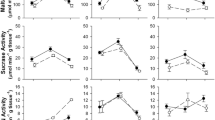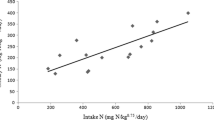Abstract
We fed prairie voles (Microtus ochrogaster) rat chow diluted with variable amounts of α-cellulose to determine 1) how much fiber the voles could tolerate in their diet; 2) changes in food intake and digestibility of dry matter and of fiber; 3) the extent to which voles utilized fiber as an energy source; and 4) whether any of these variables differed between groups of animals maintained at 5 or 22°C. Fiber content of the diets ranged from 20 to 84%. Animals held at 5°C maintained body mass through a diet containing 69% fiber, while animals held at 22°C maintained body mass through the 84% fiber diet. Dry matter intake increased with fiber level from 9.3 to 15.0 g·day-1 for animals at 5°C and from 5.6 to 14.0 g·day-1 for animals at 22°C; intake on the highest fiber diet eaten by either group was not different. Dry matter digestibility decreased significantly as the fiber in the diets increased, but was not affected by temperature treatments. Digestible dry matter intake for each group remained constant regardless of diet quality, but on each diet digestible dry matter intake for animals at 5°C was significantly higher than that of the animals held at 22°C. Digestibility of the fiber portion of the experimental diets remained constant as food quality decreased, so the percent of daily energy need met by fiber utilization increased with higher food intake. On the lowest quality diet each group tolerated, fiber digestion provided approximately 42 and 68% of the energy needs of voles at 5 and 22°C, respectively.
Similar content being viewed by others
Abbreviations
- BM:
-
body mass
- BMR:
-
basal metabolic rate
- DE:
-
digestible energy
- DM:
-
dry matter
- DMD:
-
dry matter digestibility
- DDMI:
-
digestible dry matter intake
- MR:
-
metabolic rate
- NDF:
-
neutral detergent fiber (=cell walls)
- NDS:
-
neutral detergent solubles (=cell solubles)
- SEM:
-
standard error of mean
- T a :
-
ambient temperature
References
Allen MS, Mertens DR (1988) Evaluating constraints on fiber digestion by rumen microbes. J Nutr 118: 261–270
Baker DL, Hobbs NT (1987) Strategies of digestion: digestive efficiency and retention time of forage diets in montane ungulates. Can J Zool 65: 1978–1984
Batzli GO (1985) Nutrition. In: Tamarin RH (ed) Biology of new world Microtus. Am Soc Mammal, pp 779–811
Batzli GO, Cole FR (1979) Nutritional ecology of microtine rodents: digestibility of forage. J Mammal 60: 740–750
Bjorndal KA, Bolton AB, Moore JE (1990) Digestive fermentation in herbivores: effect of food particle size. Physiol Zool 63: 710–721
Bjornhag G (1972) Separation and delay of contents in the rabbit colon. Swed J Agricult Res 2: 125–136
Chilcott MJ, Hume ID (1985) Coprophagy and selective retention of fluid digesta: their role in the nutrition of the ringtail possum, Pseudocheirus peregrinus. Aust J Zool 33: 1–15
Demment MW, Van Soest PJ (1985) A nutritional explanation for body-size patterns of ruminants and noruminant herbivores. Am Nat 125: 641–672
Foley WJ, Cork SJ (1992) Use of fibrous diets by small herbivores: how far can the rules be ‘bent’? Trends Ecol Evol 7: 159–162
Fryxell JM (1991) Forage quality and aggregation by large herbivores. Am Nat 138: 478–498
Green DA, Millar SJ (1987) Changes in gut dimensions and capacity of Peromyscus maniculatus relative to diet quality and energy needs. Can J Zool 65: 2159–2162
Gross JE, Wang Z, Wunder BA (1985) Effects of food quality and energy needs: changes in gut morphology and capacity of Microtus ochrogaster. J Mammal 664: 661–667
Hammond KA (1989) The role of diet quality and energy need in the nutritional ecology of a small herbivore. Ph.D. Thesis, Colorado State University, Ft. Collins, USA
Hammond KA, Wunder BA (1991) The role of diet quality and energy need in the nutritional ecology of a small herbivore, Microtus ochrogaster. Physiol Zool 64: 541–567
Hammond KA, Diamond JM (1992) An experimental test for a ceiling on sustained metabolic rate in lactating mice. Physiol Zool 65: 952–977
Holtenius K, Bjornhag G (1985) The colonic separation mechanism in the guinea-pig (Cavia porcellus) and the chinchilla (Chinchilla laniger). Comp Biochem Physiol 82A: 537–542
Hoover WH, Clark SD (1972) Fiber digestion in the beaver. J Nutr 102: 9–16
Hoover WH, Heitmann RN (1972) Effects of dietary fiber levels on weight gain, cecal volume and volatile fatty acid production in rabbits. J Nutr 102: 375–380
Hörnicke H, Bjornhag G (1980) Coprophagy and related strategies for digesta utilization. In: Ruckenbush Y, Thivend P (eds) Digestive physiology and metabolism in ruminants. MTP Press, Lancaster, pp 707–730
Hume ID, Morgan KR, Kenagy GJ (1993) Digesta retention and digestive performance in Sciurid and Microtine rodents: effects of hindgut morphology and body size. Physiol Zool 66: 396–411
Janis C (1976) The evolutionary strategy of the Equidae and the origins of rumen and cecal digestion. Evolution 30: 757–774
Justice KE, Smith FA (1992) A model of dietary fiber utilization by small mammalian herbivores, with empirical results for Neotoma. Am Nat 139: 398–416
Kenagy GJ, Hoyt DF (1980) Reingestion of faeces in rodents and its daily rhythmicity. Oecologia 44: 403–409
Keys JE, Van Soest (1970) Digestibility of forages by the meadow vole Microtus pennsylvanicus. J Dairy Sci 53: 1502–1508
Kleiber M (1961) The fire of life. Wiley, New York
Lee WB, Houston DC (1993) The effect of diet quality on gut anatomy in British voles (Microtinae). J Comp Physiol B 163: 337–339
Loeb SC, Sehwab RG, Demment MW (1991) Responses of pocket gophers (Thomomys bottae) to changes in diet quality. Oecologia 86: 542–551
Milliken GA, Johnson DE (1984) Analysis of messy data. Van Nostrand Reinhold, New York
Montgomery MJ, Baumgardt BR (1965a) Regulation of food intake in ruminants. 1. Pelleted rations varying in energy concentration. J Dairy Sci 48: 569–577
Montgomery MJ, Baumgardt BR (1965b) Regulation of food intake in ruminants. 2. Rations varying in energy concentration and physical form. J Dairy Sci 48: 1623–1628
Nagy TR, Negus NC (1993) Energy acquisition and allocation in male collared lemmings (Dicrostonyx groenlandicus): effects of photoperiod, temperature, and diet quality. Physiol Zool 66: 537–560
Parra R (1978) Comparison of foregut and hindgut fermentation in herbivores. In: Montgomery GG (ed) The ecology of arboreal folivores. Smithsonian Institution, Washington, D.C., pp 205–230
Penry DL, Jumars PA (1987) Modeling animal guts as chemical reactors. Am Nat 129: 69–96
Robbins CT (1983) Wildlife feeding and nutrition. Academic Press, Orlando
Robles AY, Belyea FA, Martz FA, Weiss MF (1980) Effect of particle size upon digestible cell wall and rate of in vitro digestion of alfalfa and orchard-grass forages. J Anim Sci 51: 783–790
Sakaguchi E, Kaizu K, Nakamichi M (1992) Fibre digestion and digesta retention from different physical forms of the feed in the rabbit. Comp Biochem Physiol 102A: 559–563
Short HL, Blair RM, Segelquist CA (1974) Fiber composition and forage digestibility by small ruminants. J Wildl Manage 38: 197–209
Sibly RM (1981) Strategies of digestion and defecation. In: Townsend CR, Calow PA (eds) Physiological ecology: an evolutionary approach to resource use. Blackwell, Oxford, pp 109–139
Toloza EM, Lam M, Diamond JM (1991) Nutrient extraction by cold-exposed mice: a test of digestive safety margins. Am J Physiol 261: G608–G620
Van Soest PJ (1982) Nutritional ecology of the ruminant. O & B Books, Corvallis
Weston RH, Poppi DP (1987) Comparative aspects of food intake. In: Hacker JB, Ternouth JH (eds) The nutrition of herbivores. Academic Press, Sydney, pp 133–161
Woodall PF (1989) The effects of increased dietary cellulose on the anatomy physiology, and behavior of captive water voles, Arvicola terrestris L. (Rodentia: Microtinae). Comp Biochem Physiol 94A: 615–621
Wunder BA (1985) Energetics and thermoregulation. In: Tamarin RH (ed) Biology of New World Microtus. Am Soc Mammal, pp 812–844
Yahav S, Choshniak I (1990) Response of the digestive tract to low quality dry food in the fat jird Meriones crassus and the levant vole Microtus guentheri. J Arid Environ 19: 209–215
Yang MG, Manoharan K, Young AK (1969) Influence and degradation of dietary cellulose in cecum of rats. J Nutr 97: 260–264
Author information
Authors and Affiliations
Rights and permissions
About this article
Cite this article
Castle, K.T., Wunder, B.A. Limits to food intake and fiber utilization in the prairie vole, Microtus ochrogaster: effects of food quality and energy need. J Comp Physiol B 164, 609–617 (1995). https://doi.org/10.1007/BF00389801
Accepted:
Issue Date:
DOI: https://doi.org/10.1007/BF00389801




